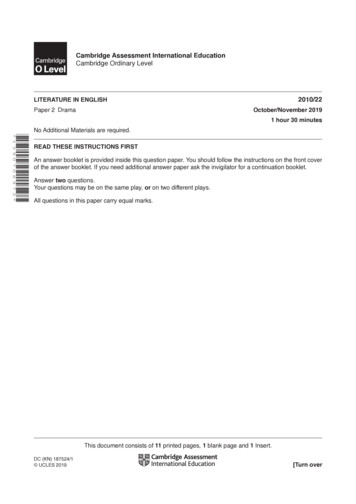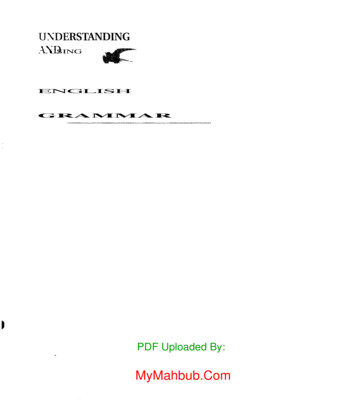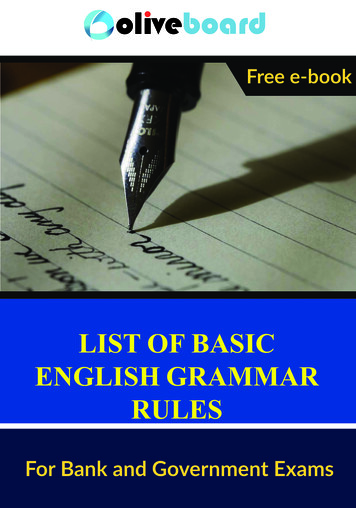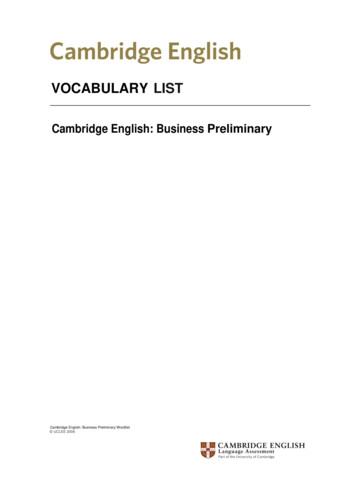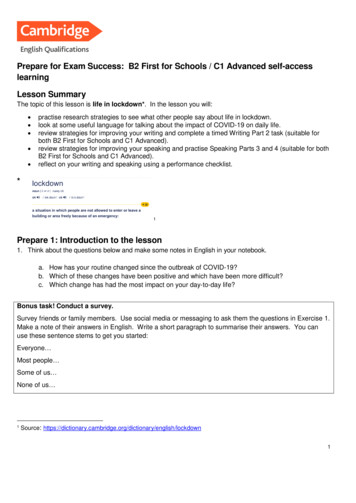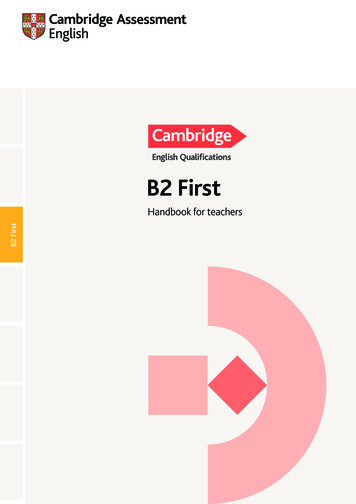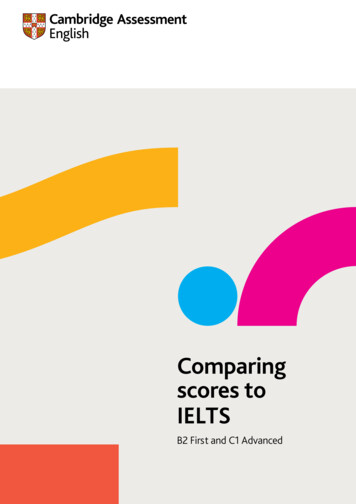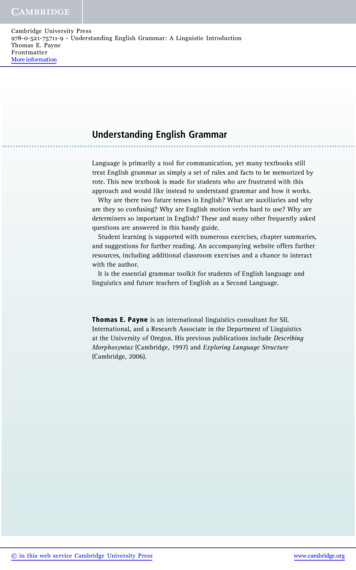
Transcription
Cambridge University Press978-0-521-75711-9 - Understanding English Grammar: A Linguistic IntroductionThomas E. PayneFrontmatterMore informationUnderstanding English Grammar.Language is primarily a tool for communication, yet many textbooks stilltreat English grammar as simply a set of rules and facts to be memorized byrote. This new textbook is made for students who are frustrated with thisapproach and would like instead to understand grammar and how it works.Why are there two future tenses in English? What are auxiliaries and whyare they so confusing? Why are English motion verbs hard to use? Why aredeterminers so important in English? These and many other frequently askedquestions are answered in this handy guide.Student learning is supported with numerous exercises, chapter summaries,and suggestions for further reading. An accompanying website offers furtherresources, including additional classroom exercises and a chance to interactwith the author.It is the essential grammar toolkit for students of English language andlinguistics and future teachers of English as a Second Language.Thomas E. Payne is an international linguistics consultant for SILInternational, and a Research Associate in the Department of Linguisticsat the University of Oregon. His previous publications include DescribingMorphosyntax (Cambridge, 1997) and Exploring Language Structure(Cambridge, 2006). in this web service Cambridge University Presswww.cambridge.org
Cambridge University Press978-0-521-75711-9 - Understanding English Grammar: A Linguistic IntroductionThomas E. PayneFrontmatterMore informationUnderstandingEnglish GrammarA Linguistic IntroductionTHOMAS E. PAYNEUNIVERSITY OF OREGON AND SIL INTERNATIONAL in this web service Cambridge University Presswww.cambridge.org
Cambridge University Press978-0-521-75711-9 - Understanding English Grammar: A Linguistic IntroductionThomas E. PayneFrontmatterMore informationCAMBRIDGE UNIVERSITY PRESSCambridge, New York, Melbourne, Madrid, Cape Town, Singapore,São Paulo, Delhi, Dubai, Tokyo, Mexico CityCambridge University PressThe Edinburgh Building, Cambridge CB2 8RU, UKPublished in the United States of America by Cambridge University Press, New Yorkwww.cambridge.orgInformation on this title: www.cambridge.org/9780521757119# Thomas E. Payne 2011This publication is in copyright. Subject to statutory exceptionand to the provisions of relevant collective licensing agreements,no reproduction of any part may take place withoutthe written permission of Cambridge University Press.First published 2011Printed in the United Kingdom at the University Press, CambridgeA catalogue record for this publication is available from the British LibraryLibrary of Congress Cataloging-in-Publication DataPayne, Thomas Edward, 1951–Understanding English grammar : a linguistic introduction / Thomas E. Payne.p.cm.Includes bibliographical references.ISBN 978-0-521-76329-5 (Hardback) – ISBN 978-0-521-75711-9 (pbk.)1. English language–Grammar. 2. Language and languages–Study and teaching.PE1109.P39 2011425–dc22 2010020969I. Title.ISBN 978-0-521-76329-5 HardbackISBN 978-0-521-75711-9 PaperbackAdditional resources for this publication at www.cambridge.org/payneCambridge University Press has no responsibility for the persistence oraccuracy of URLs for external or third-party Internet websites referred toin this publication, and does not guarantee that any content on suchwebsites is, or will remain, accurate or appropriate. in this web service Cambridge University Presswww.cambridge.org
Cambridge University Press978-0-521-75711-9 - Understanding English Grammar: A Linguistic IntroductionThomas E. PayneFrontmatterMore informationDedicated to students in the Hanyang–Oregon TESOLprogram at Hanyang University, 2004–2009 in this web service Cambridge University Presswww.cambridge.org
Cambridge University Press978-0-521-75711-9 - Understanding English Grammar: A Linguistic IntroductionThomas E. PayneFrontmatterMore informationContentsList of figuresList of tablesPrefaceAcknowledgementsList of typographical conventions and abbreviationsIntroduction1234What is “English”?What is a linguistic perspective?Form, meaning, and useSummaryxxixiixivxv12417201 History211.11.21.31.41.51.6222527293233The Celtic threadThe Anglo-Saxon threadThe Scandinavian (Northern Germanic) threadThe Latin threadContemporary influencesThe genius of English2 Typology2.1 Morphological typology2.2 Constituent order typology2.3 Lexical typology3 The lexicon3.13.23.33.43.5Characteristics of items in the lexiconThe boundaries of the lexiconLexicalizationClasses in the lexiconConclusion: the lexicon and language learning in this web service Cambridge University Press36374246575758606677www.cambridge.org
Cambridge University Press978-0-521-75711-9 - Understanding English Grammar: A Linguistic IntroductionThomas E. PayneFrontmatterMore informationviiiContents4 Morphology – the shapes of words4.14.24.34.44.54.6Some basic concepts in morphologyTypes of morphemesDerivational vs. inflectional morphologyMorphologically complex structures and the notion of derivationPhonosemantics and contextual meaningConclusion5 Participant reference5.1 Properties of nouns5.2 Subclasses of nouns5.3 Pronouns6 Actions, states, and processes6.16.26.36.4Semantic rolesVerb subclassesThe forms of English verbs“Phrasal verbs” – on the cutting edge of the lexicon7 Basic concepts in English syntax7.17.27.37.4Universal features of syntactic structureSyntactic categories and syntactic functionsTests for constituent structureConstituent structure trees8 Advanced concepts in English syntax8.18.28.38.4The DP hypothesisThe functions of DPs vs. NPs – why distinguish the two?The GP hypothesisThe IP hypothesis9 Complementation9.19.29.39.49.59.6Predication and Complementation illustratedSubject ComplementsObject ComplementsSummary of Subject and Object ComplementsSubject–Complement inversion constructionsExistential and presentational constructions in this web service Cambridge University ww.cambridge.org
Cambridge University Press978-0-521-75711-9 - Understanding English Grammar: A Linguistic IntroductionThomas E. PayneFrontmatterMore informationixContents10 Modification22810.1 Modification in the noun phrase10.2 Modification in the Predicate10.3 Modification at the clause level22924324711 Auxiliaries and the “black hole” of English syntax11.111.211.311.411.511.6253Types of auxiliariesThe black holeMorphosyntactic properties of auxiliariesLexical be as an active, regular verbConsequences for pedagogyConclusion25425826126827427512 Time and reality27912.1 Tense12.2 Aspect12.3 Modality28028529613 Voice and valence30213.113.213.313.4Valence theoryA functional typology of valence-adjusting constructionsValence-decreasing constructionsValence-increasing constructions30330630731714 Clause combining14.114.214.314.414.5Monoclausal verb combinationsThe forms of dependent clauses – the scale of grammatical dependencyThe functions of dependent clausesCoordinationForms and functions of dependent clauses summarized15 Pragmatic grounding and pragmatically marked constructions15.115.215.315.4328Pragmatic statusesThe morphosyntax of focus, contrast, and “topicalization”NegationNon-declarative speech actsGlossaryEndnotesReferencesIndex in this web service Cambridge University .cambridge.org
Cambridge University Press978-0-521-75711-9 - Understanding English Grammar: A Linguistic IntroductionThomas E. PayneFrontmatterMore 112.212.312.414.114.2The form–meaning compositepage 6The interrelationships among form, meaning, and use18Ogham inscription23The index of synthesis38The index of fusion40Linguistic approaches to the lexicon58The diachronic path from full lexical word to grammatical functor66Summary diagram of types of morphemes in English, with examples93Nouns and discourse referents107Properties of lexical entries108The continuum between Oblique adjuncts and Subject Complements215The relationship between form and meaning in the TAM systems of English 280The conceptual domain of tense280Conceptual categories in the domain of time295Conceptual categories in the domain of reality299The scale of grammatical dependency331Scale of semantic dependency correlated with the scale of grammaticaldependency342 in this web service Cambridge University Presswww.cambridge.org
Cambridge University Press978-0-521-75711-9 - Understanding English Grammar: A Linguistic IntroductionThomas E. PayneFrontmatterMore 5.25.35.45.57.19.111.111.212.112.213.114.115.1The personal pronouns of Englishpage 39Spanish verb inflections – an example of a relatively synthetic language41English verb inflections – an example of a relatively isolating language41Summary of Greenberg’s universals44A comparison of full lexical words and grammatical functors67Free and bound Latinate roots84A few noun–verb pairs that illustrate “stress shift”86Stem change as a morphological process: the past tenses of someminor class verbs91The past tenses of some “irregular” (suppletive) verbs92Some derivational affixes of English97Some groups of nouns normally used in a non–countable sense115Pluralia tantum nouns119Personal pronouns of Contemporary Standard English124Interrogative pronouns of CSE126Demonstrative pronouns128Syntactic categories used in this book165Stative and inchoative Subject and Object Complements compared219Sequencing of modal and non-modal auxiliaries256Comparison of frequency of double-modal constructions257Distribution of will and be going to in the BNC284Grammatical tense and grammatical aspect in English286A functional typology of valence-adjusting constructions307Summary of English dependent clause forms and functions354Objective referentiality and identifiability366 in this web service Cambridge University Presswww.cambridge.org
Cambridge University Press978-0-521-75711-9 - Understanding English Grammar: A Linguistic IntroductionThomas E. PayneFrontmatterMore informationPrefaceThe grammar of a language is a dynamic, constantly changing set of habit patternsthat allows people to communicate with one another. For some reason, many inacademia and language teaching seem to have lost sight of this common sensetruth, preferring to treat grammar as though it were an object, outside of humanbeings in society, consisting of absolute categories and rules. This misperceptionhas led to a deep tension between theoreticians and the practical needs of languageteachers, whose students often come to believe that grammar is a tedious classroomsubject, to be endured as a kind of rite of passage, rather than a key to the amazingworld of human communication.In recent years linguistics has begun to recognize the importance of language inuse to general understandings of human cognition, communication, and culture.This orientation, combined with developments in computational technology, hasled to more pragmatic, data-driven, theoretical perspectives as linguists look at theway people actually communicate rather than the ideal systems enshrined incountless textbooks of the last century. This book attempts to bring currentlinguistic understandings to bear on practical tasks, such as language teaching,learning, and translating. It attempts to balance systematicity with creativity,absolutism with flexibility. It takes into account the fact that grammar is thoroughly human, deeply linked with culture and identity, and stunningly complex.I hope that this book will promote genuine understanding of English grammarby answering the “why” questions that students often ask, e.g., “Why are auxiliaries so confusing?,” “Why does English make such a big deal out of determiners?,”“Why are there two ‘future tenses’?,” “Why do my students have such a hard timeusing English motion verbs?,” and so on. The principle assertion is that grammarcan be understood and appreciated as a practical system for communication. Thisperspective has the potential to inspire teachers and students with a genuineenthusiasm for grammar, replacing the frustration often engendered by a moretraditional approach.This book has been written for, and in consultation with, students preparing forcareers as English language professionals. Most such students around the world arepreparing to teach English as a foreign or second language in TESOL, TEFL, or TESLprograms. However, “English Grammar,” “The Structure of English,” or othersimilar course titles are taught in a variety of academic programs, includingcommunication studies, journalism, linguistics, and applied linguistics, to name a in this web service Cambridge University Presswww.cambridge.org
Cambridge University Press978-0-521-75711-9 - Understanding English Grammar: A Linguistic IntroductionThomas E. PayneFrontmatterMore informationxiiiPrefacefew. A previous or concurrent course in introduction to linguistics or phoneticswould be helpful, but is not strictly necessary as a prerequisite to a course that usesthis book.In the following pages are hundreds of examples from two of the major onlinecorpora of English: the British National Corpus (BNC), accessed via the BrighamYoung University interface (Davies 2004), and the Corpus of ContemporaryAmerican English (COCA), also accessed via the BYU interface (Davies 2008). Otherdata come from the Internet (searches by Google), the Internet Movie Data Base(www.imdb.com), contemporary literature, and from personal conversations.Invented examples are used occasionally, and are identified as such.I have tried to choose examples that will not be offensive or sound biased in anyway. However, because the examples are from language in use, they r
978-0-521-75711-9 - Understanding English Grammar: A Linguistic Introduction Thomas E. Payne Frontmatter More information. Preface The grammar of a language is a
